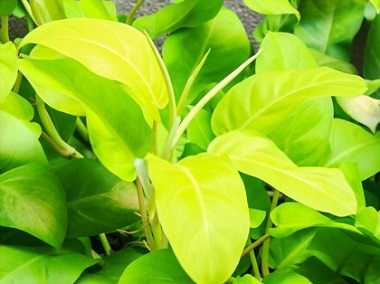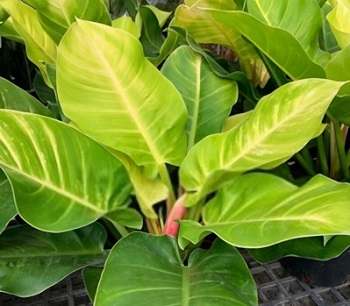Suppose you want a plant that will give your home interior a look that will amaze all your guests. Then it would help if you got a Philodendron Hederaceum or Lemon Lime Philodendron. Captain William Bligh discovered this plant in the 1970s. It is mostly found in America.
The best part is that the Lemon Lime Philodendrons have flowing colored leaves, usually bearing the color schemes of brilliant yellow to lime. Moreover, this plant species is evergreen, which means it will stay attractive throughout the year.
Post Contents
- Philodendron Lemon Lime Quick Overview:
- Philodendron Lemon Lime Care Guide:
- Proper Light and Location:
- Watering Requirements:
- The Right Temperature:
- Humidity Requirements:
- Potting Soil Mix:
- Fertilization:
- Potting and Repotting:
- Timely Pruning:
- Toxicity of Philodendron Lemon Lime:
- Philodendron Lemon Lime Propagation:
- FAQS about Philodendron Lemon Lime:
- Conclusion:
- Author
Philodendron Lemon Lime Quick Overview:
| Aspect | Details |
|---|---|
| Common Name | Philodendron Lemon Lime |
| Scientific Name | Philodendron hederaceum ‘Lemon Lime’ |
| Family | Araceae |
| Origin | Hybrid cultivar; derived from P. hederaceum |
| Growth Habit | Vine-like, trailing |
| Light Requirement | Bright, indirect light |
| Watering Frequency | Moderate; allow the top inch of soil to dry out before watering again |
| Soil Type | Well-draining potting mix, rich in organic matter |
| Temperature | 18-24°C (65-75°F) |
| Humidity | Moderate to high humidity |
| Height | Up to 1-2 feet |
| Spread | Up to 1-2 feet |
| Foliage Color | Vibrant lime green |
| Pruning | Remove yellowing or damaged leaves |
| Propagation | Stem cuttings, air layering, or division |
| Toxicity | Mildly toxic if ingested; keep away from pets and children |
Philodendron Lemon Lime Care Guide:
You must take proper care of this plant, as it requires specific amounts of every element that a plant needs to thrive. You should provide the Lemon Lime with ambient temperatures, soil with good properties, proper hydration, the right light, nutrients, etc.
You should consider all these points if you are getting a Philodendron Lemon Lime. Let’s start with the main body of the article:
Read Also: Is Moss a Fungus? – (Complete Guide About Moss)
Proper Light and Location:
It’s a bit difficult to understand this plant regarding lighting needs. This plant can bear low light conditions like a shaded area, but it can never bear direct and scorching sunlight because this will burn the foliage making the leaves yellowed. Moreover, it can overall make the plant droopy.
The plant thrives in bright light but doesn’t fall directly on the plant. It is really important for obtaining beautiful and luxuriant leaves.

Remember that the Lemon Lime grows in low light but will grow the best in indirect bright light. So ensure it is in perfect condition in terms of lighting.
For adequate sunlight, you can place your plant in a bright location that receives plenty of indirect sunlight, and we recommend a north-facing window or vent.
Related Post: Philodendron Rojo Congo Care & Growing Guide (Red Congo)
Watering Requirements:
Being a tropical plant, the Philodendron Lemon Lime has high demand in terms of watering. Understand your plant with its look.
Examine your plant regularly, and see if your plant’s foliage is looking brownish or it is becoming soft, wilted, or yellowed. This is an indication that your plant is receiving less than normal water.
Besides all this, if your plant seems a bit pulpy and tends to lose its yellow-green color. It is a confirmed case of over-watering.
Watering your Philodendron Lemon Lime is not difficult. Just remember that it needs more water during growing periods and less water during the cold months.
This is because, during winter, the plant growth slows down. Water it once a week in the growing season, and in colder months, make this to once a month.
Never let water get accumulate in the pot of your plant. This will avoid over-watering. Moreover, examine the soil when watering, then water according to the soil’s moisture level. We recommend investing in a moisture meter.
If by chance, you forget to water your plant, you can easily rehydrate your plant. Please take it to the kitchen or washroom sink, and then water it thoroughly under the tap until the water drains out of the draining holes. This will wet the soil throughout. After this, get rid of the excess water.
The Right Temperature:
You have to keep the temperature in the range that is between 60 degrees Fahrenheit to 75 degrees Fahrenheit. The evening temperature can be 5 to 10 degrees but not too low.
Overall remember that the temperature should be above 55 degrees Fahrenheit. The Philodendron Lemon Lime can never handle cold and freezing temperatures.
We recommend using heat pads and frost blankets during the winter. Moreover, you can use some straw or dried grass to cover your plant’s soil, which will prevent heat loss. This plant is cold-sensitive. Ensure good care during winter and never keep it near open vents.
Humidity Requirements:
This plant can grow easily in the ordinary humidity of your home. But as the foliage of the Lemon Lime Philodendron spreads, the humidity requirement will increase.
Lemon Lime Philodendron usually needs humidity levels that are between 40% to 60%. Opt for an inexpensive humidifier to keep up with the humidity requirements. We recommend placing your pot in a tray with pebbles and water.

You can mist your plant with a sprayer, increasing the air humidity around the plant. But don’t overdo this because a lot of misting will lead to pest issues.
Read More: Philodendron Pedatum Care & Growing (Ultimate Guide)
Potting Soil Mix:
The Philodendron Lemon Lime will need well-draining soil to thrive. A mixture that will provide hydration and proper nutrients is the best. Draining means that excess water drains quickly, so the plant doesn’t get root rot.
A soil mixture will be perfect that is loose and fertile, that will have a good passage for air and water. The best soil for Philodendron Lemon Lime is soil with a slightly acidic pH of 6.0 to alkaline 8.0.
Mix your potting soil. Take 2 parts of cocopeat, 3 parts of regular garden soil and ½ part of perlite.
Fertilization:
You can use a diluted fertilizer for your plant during the growing seasons. We recommend a mild fertilizer for the Lemon Lime, which will help the plant development.
Stop fertilizing during the winter because the chemicals in the fertilizer will cause burns on the plant’s foliage. If the soil turns creamy or whitish, you have over-fertilized your plant. To get rid of the fertilizer, you can rinse the soil thoroughly.
Potting and Repotting:
The Lemon Lime roots spread compactly and develop as a solid ‘ball of roots under the soil. So when it is young, you should repot it each year in the growing spring season. But when the plant matures, take this routine every two years.
Opt for a pot made from clay or terracotta that is slightly larger than the current one with proper drainage holes. Never use plastic pots as they cause water clogging and diseases.
Repot the plant in a bigger pot by delicately taking out the roots with a gardening spade after two years of plant extension if your plant is in good shape and health.
We recommend keeping the soil that is stuck to the root ball intact. This will avoid any disturbance to the roots.
Timely Pruning:
The recommendation for pruning Lemon Lime Philodendron is to do it once three to six months. This can depend on the size and growth rate of your Lemon Lime.
You can use a sterilized pair of scissors or cutters for this job. You can remove all the dead or discolored leaves. You can also remove any infected leaves. Don’t overdo this; ensure that you leave at least 50% of the leaves intact. Stop the pruning routine during winter.
Toxicity of Philodendron Lemon Lime:
This plant is poisonous as it has calcium oxalate in the plant cells. Keep this away from the children and pets. If it is ingested by mistake, it can lead to inflammatory swelling and vomiting.
Related Article: Philodendron Bipennifolium Care & Growing (Expert Guide)
Philodendron Lemon Lime Propagation:
The Lemon Lime Philodendron is very easy to propagate. We have mentioned the two most effective ways to do this. You can do this process only in spring or summer when the species is at the growing stage.
Only the stem cutting method is explained as it is the most common, and success rates are low with air layering.
- Stem Cutting:
For this method, you must find a perfect spot near a leaf that should be at least 2 to 4 inches long. Use sterilized tools for doing this.
After this, place the part that you got in a warm and humid place for up to two weeks. This way, you will form roots that you can place in the soil by sticking your finger.
All you have to do is take the cutting, place it in the soil, and ensure it stays firmly there. If the stem doesn’t stay upright, you can give it the support of a mossy pole or natural straw.
FAQS about Philodendron Lemon Lime:
What is Causing the Death of my Philodendron Lemon Lime?
The leading cause of your plant’s death can be either low or overwatering. Moreover, other factors that can cause death are intense sunlight and over-fertilizing.
Why are Philodendron Lemon Limes’ Leaves turning Brownish?
Less watering can cause the leaves of Lemon Lime Philodendron to turn brown. Avoid the plant from drying out. Keep the soil moist.
How can my Philodendron Lemon Lime get Denser?
A proper pruning routine can lead to a denser and bushier plant. Regularly trim the plant till it reaches the required height to encourage more trails and denser plants.
Conclusion:
The Lemon Lime Philodendron is a unique and beautiful plant that stays fresh throughout the year. This tropical beauty greatly enhances your home interior.
It is easy to maintain and also really easy to propagate if you provide the right conditions.
Furthermore, its brilliant colors will make sure to make your guests stop and admire it keenly. We recommend getting this plant as it will surely take the indoor aesthetics of your home to the next level.
Few Related Articles:

